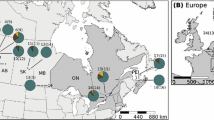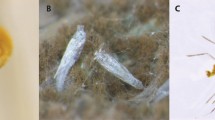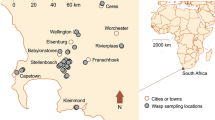Abstract
In 2004, the avocado lace bug (ALB) Pseudacysta perseae, was discovered in San Diego County, CA, USA. Historically, California avocado producers have relied on biological control for suppression of injurious pests. A fundamental step in identifying biological control agents is determining the source of the invasive population, thus allowing a focused search of that area for natural enemies most closely adapted to the invasive pest genotype. In an attempt to determine the geographic area of origin for ALB to assist incipient biological control efforts, mitochondrial and microsatellite markers were used to compare the genetic profile of the California population of ALB with that of populations from the pest’s known range in the US, Guatemala, Mexico and the Caribbean. Both types of marker revealed evidence for strong genetic structure among the sampled populations. Mitochondrial sequences narrowed the geographic origin of the California population, to populations in Texas and several Mexican states. This geographic range was refined further with the analysis of allele frequencies at eight microsatellite loci which identified ALB populations in the state of Nayarit, Mexico, as the most probable origin of the California population. Any effort to identify natural enemies of ALB for use in biological control in California should therefore focus on Nayarit. The strong genetic structure present among the ALB populations studied is discussed with regards to the potential influence of cytoplasmic incompatibility-inducing endosymbionts, host plant variation, and the putative native range of this pest.



Similar content being viewed by others
References
Almaguel L, Blanco E, Suárez P, de la Torre P, Cáceres I, Nieves C, Márquez ME, Blanco L (1999) Control de la chinche del aguacate (Pseudacysta perseae (Heidemann)) en Ciudad de La Habana. Fitosanidad 3:69–74
Baldo L, Dunning Hotopp JC, Jolley KA, Bordenstein SR, Biber SA, Choudhury RR, Hayashi C, Maiden MCJ, Tettelin H, Werren JH (2006) Multiolocus sequence typing system for the endosymbiont Wolbachia pipientis. Appl Environ Microbiol 72:7098–7110
Ballard JWO, Melvin RG (2010) Linking the mitochondrial genotype to the organismal phenotype. Mol Ecol 19:1523–1539
Bender G (1993) A new mite problem on avocados. Calif Avocado Soc Yearb 77:73–77
Benson DA, Karsch-Mizrachi I, Lipman DJ, Ostell J, Wheeler DL (2008) GenBank. Nucleic Acids Res 36:D25–D30
Braig HR, Zhou W, Dobson S, O’Neill SL (1998) Cloning and characterization of a gene encoding the major surface protein of the bacterial endosymbiont Wolbachia. J Bacteriol 180:2373–2378
Byrne FJ, Humeres EC, Urena AA, Hoddle MS, Morse JG (2010) Field evaluation of systemic imidacloprid for the management of avocado thrips and avocado lace bug in California avocado groves. Pest Manag Sci 66:1129–1136
Campbell BC, Steffen-Campbell JD, Werren JH (1993) Phylogeny of the Nasonia species complex (Hymenoptera: Pteromalidae) inferred from an rDNA internal transcribed spacer (ITS2) and 28 s rDNA sequences. Insect Mol Biol 2:225–237
Campbell B, Heraty JM, Rasplus J-Y, Chan K, Steffen-Campbell J, Babcock C (2000) Molecular systematics of the Chalcidoidea using 28 s-D2 rDNA. In: Austin A, Dowton M (eds) The Hymenoptera: evolution, biodiversity and biological control. CSIRO Publishing, Victoria, pp 57–71
Chen H, Morrell PL, Ashworth VETM, de la Cruz M, Clegg MT (2009) Tracing the geographic origin of major avocado cultivars. J Hered 100:56–65
Clement M, Posada D, Crandall KA (2000) TCS: a computer program to estimate gene genealogies. Mol Ecol 9:1657–1659
Cornuet J-M, Luikart G (1996) Description and power analysis of two tests for detecting recent population bottlenecks from allele frequency data. Genetics 144:2001–2014
Crane JH, Balerdi CF, Maguire I (2007) Avocado growing in the Florida home landscape. Circular 1034, Horticultural Sciences Department, Florida Cooperative Extension Service, Institute of Food and Agricultural Sciences, University of Florida
de la Torre P, Almaguel L, Blanco E (1999) Daños, distribución y enemigos naturales de la chinche de encaje del aguacate Pseudacysta perseae (Heidemann) (Hemiptera: Tingidae). Fitosanidad 3:69–74
Dlugosch KM, Parker M (2008) Founding events in species invasions: genetic variation, adaptive evolution, and the role of multiple introductions. Mol Ecol 17:431–449
Earl DA (2010) Structure Harvester v0.56.4. http://taylor0.biology.ucla.edu/struct_harvest/. Accessed 28 Feb 2011
Evanno G, Regnaut S, Goudet J (2005) Detecting the number of clusters of individuals using the software STRUCTURE: a simulation study. Mol Ecol 14:2611–2620
Excoffier L, Smouse P, Quattro J (1992) Analysis of molecular variance inferred from metric distances among DNA haplotypes: application to human mitochondrial DNA restriction data. Genetics 131:479–491
Excoffier L, Laval G, Schneider S (2005) Arlequin ver. 3.0: an integrated software package for population genetics data analysis. Evol Bioinforma Online 1:47–50
Folmer O, Black M, Hoeh W, Lutz R, Vrijenhoek R (1994) DNA primers for amplification of mitochondrial cytochrome c oxidase subunit I from diverse metazoan invertebrates. Mol Mar Biol Biotechnol 3:294–299
Gagné R, Peña JE, Acevedo FE (2008) A new Lestodiplosine (Diptera: Cecidomyiidae) preying on the avocado lace bug, Pesudacysta perseae (Hemiptera: Tingidae) in southern Florida. Fla Entomol 91:43–48
Gottlieb Y, Ghanim M, Chiel E, Gerling D, Portnoy V, Steinberg S, Tzuri G, Horowitz AR, Belausov E, Mozes-Daube N, Kontsedalov S, Gershon M, Gal S, Katzir N, Zchori-Fein E (2006) Identification and localization of a Rickettsia sp. in Bemisia tabaci (Homoptera: Aleyrodidae). Appl Environ Microbiol 72:3646–3652
Goudet J (1995) FSTAT (version 1.2): a computer program to calculate F-statistics. J Hered 86:485–486
Goudet J (2001) FSTAT, version 2.9.3: a program to estimate and test gene diversities and fixation indices. Institute of Ecology, University of Lausanne, Switzerland. http://www2.unil.ch/popgen/softwares/fstat.htm. Accessed 28 Feb 2011
Guo SW, Thompson EA (1992) Performing the exact test of Hardy–Weinberg proportion for multiple alleles. Biometrics 48:361–372
Hall TA (1999) BioEdit: a user friendly biological sequence alignment and analysis program from Windows 95/98/NT. Nucleic Acids Symp 41:95–98
Hebert PDN, Cywinska A, Ball SL, deWard JR (2003) Biological identifications through DNA barcodes. Proc R Soc Lond B 270:313–321
Hebert PDN, Penton EH, Burns JM, Janzen DH, Hallwachs W (2004) Ten species in one: DNA barcoding reveals cryptic species in the neotropical skipper butterfly Astraptes fulgerator. Proc Natl Acad Sci USA 101:14812–14817
Heidemann O (1908) Two species of North American Tingitidae (Hemiptera: Heteroptera). Proc Entomol Soc Wash 10:103–108
Henry TJ, Peña JE, Long D, Acevedo F (2009) Stethoconus praefectus (Hemiptera: Miridae): first North American records of an old world plant bug predacious on avocado lace bug, Pseudacysta perseae (Hemiptera: Tingidae), in Florida. Proc Entomol Soc Wash 111:98–105
Hoddle MS (2004) Invasions of leaf feeding arthropods: why are so many new pests attacking California grown avocados? Calif Avocado Soc Yearb 87:65–81
Hoddle MS, Morse JG (2003) Avocado thrips biology and control. AvoResearch, California Avocado Commission, Irvine
Hoddle MS, Jetter KM, Morse JG (2003) The economic impact of Scirtothrips perseae Nakahara (Thysanoptera: Thripidae) on California avocado production. Crop Prot 22:485–493
Hoddle MS, Morse J, Stouthamer R, Humeres E, Jeong G, Roltsch W, Bender GS, Phillips P, Kellum D, Dowell R, Witney GW (2005) Avocado lace bug in California. Calif Avocado Soc Yearb 88:67–79
Humeres EC, Morse JG (2006) Resistance of avocado thrips (Thysanoptera: Thripidae) to sabadilla, a botanically derived bait. Pest Manag Sci 62:886–889
Humeres EC, Morse JG, Roltsch W, Hoddle MS (2009a) Detection surveys and population monitoring for Pseudacysta perseae on avocados in Southern California. Fla Entomol 92:382–385
Humeres EC, Morse JG, Stouthamer R, Roltsch W, Hoddle MS (2009b) Evaluation of natural enemies and insecticides for control of Pseudacysta perseae (Hemiptera: Tingidae) on avocados in Southern California. Fla Entomol 92:35–42
Hunter MS, Perlman SJ, Kelly SE (2003) A bacterial symbiont in the Bacterioidetes induces cytoplasmic incompatibility in the parasitoid wasp Encarsia pergandiella. Proc R Soc Lond B 270:2185–2190
Hurst GDD, Jiggins FM (2005) Problems with mitochondrial DNA as a marker in population, phylogeographic and phylogenetic studies: the effects of inherited symbionts. Proc R Soc Lond B 272:1525–1534
Jakobsson M, Rosenberg NA (2007) CLUMPP: a cluster matching and permutation program for dealing with label switching and multimodality in analysis of population structure. Bioinformatics 23:1801–1806
Librado P, Rozas J (2009) DnaSP v.5: a software for comprehensive analysis of DNA polymorphism data. Bioinformatics 25:1451–1452
Luikart G, Allendorf FW, Cornuet J-M, Sherwin WB (1998) Distortion of allele frequency distributions provides a test for recent population bottlenecks. J Hered 89:238–247
McMurtry JA (1992) The role of exotic natural enemies in the biological control of insect and mite pests of avocado in California. In: Proceedings of II world avocado congress, pp 247–252
Mead F, Peña JE (1991) Avocado lace bug, Pesudacysta perseae (Hemiptera: Tingidae). Entomology Circular No. 346, Florida Department of Agriculture & Consumer Services, Division of Plant Industry
Mills NJ, Daane KM (2005) Biological and cultural controls … Nonpesticide alternatives can suppress crop pests. Cal Ag 59:23–28
Mitsuhashi W, Saiki T, Wei W, Kawakita H, Sato M (2002) Two novel strains of Wolbachia coexisting in both species of mulberry leafhoppers. Insect Mol Biol 11:577–584
Nei M (1978) Estimation of average heterozygosity and genetic distance from a small number of individuals. Genetics 89:582–590
Noda H, Koizumi Y, Zang Q, Deng K (2001) Infection density of Wolbachia and incompatibility lecel in two planthopper species, Laodelphax striatellus and Sagatella furcifera. Insect Biochem Mol Biol 31:727–737
Peña JE (2003) Pests of avocado in Florida. In: Proceedings of V world avocado congress, pp 487–494
Peña JE, Sundhari S, Hunsberger A, Duncan R, Schaffer B (1998) Monitoring, damage, natural enemies and control of avocado lace bug, Pseudacysta perseae (Hemiptera: Tingidae). Proc Fla State Hortic Soc 111:330–334
Peña JE, Triapitsyn SV, Long D, Evans GA, Roltsch W (2009) First record of Erythmelus klopomor (Hymenoptera: Mymaridae) as a parasitoid of the avocado lace bug, Pseudacysta perseae (Heteroptera: Tingidae). Fla Entomol 92:394–395
Perlman SJ, Hunter MS, Zchori-Fein E (2006) The emerging diversity of Rickettsia. Proc R Soc Lond B 273:2097–2106
Pritchard JK, Stephens M, Donnelly P (2000) Inference of population structure using multilocus genotype data. Genetics 155:945–959
Pruett CL, Winker K (2008) The effects of sample size on population genetic diversity estimates in song sparrows Melospiza melodia. J Avian Biol 39:252–256
Rambaut A (2009) FigTree, ver. 1.3.1 [online]. http://tree.bio.ed.ac.uk/software/figtree/. Accessed 21 Dec 2010
Raymond M, Rousset F (1995) GENEPOP (version 1.2): population genetics software for exact tests and ecumenicism. J Hered 86:248–249
Rose M, Wooley JB (1984) Previously imported parasite may control invading whitefly. Calif Avocado Soc Yearb 68:127–131
Rousset F (2008) Genepop’007: a complete reimplementation of the Genepop software for Windows and Linux. Mol Ecol Resour 8:103–106
Rozen S, Skaletsky HJ (2000) Primer3 on the WWW for general users and for biologist programmers. In: Krawetz S, Misener S (eds) Bioinformatics methods and protocols: methods in molecular biology. Humana Press, Totowa, pp 365–386
Rugman-Jones PF, Hoddle MS, Stouthamer R (2007) Population genetics of Scirtothrips perseae: tracing the origin of a recently introduced exotic pest of Californian avocado orchards, using mitochondrial and microsatellite DNA markers. Entomol Exp Appl 124:101–115
Sandoval Cabrera MF, Cermeli M (2005) Presencia de Pseudacysta perseae (Heidemann, 1908) (Insecta: Hemiptera: Tingidae) en Venezuela. Entomotropica 20:271–273
Sintupachee S, Milne JR, Poonchaisri S, Baimai V, Kittaypong P (2006) Closely related Wolbachia strains within the pumpkin arthropod community and the potential for horizontal transmission via the plant. Microb Ecol 51:294–301
Slatkin M (1995) A measure of population subdivision based on microsatellite allele frequencies. Genetics 139:457–462
Song H, Buhay JE, Whiting MF, Crandall KA (2008) Many species in one: DNA barcoding overestimates the number of species when nuclear mitochondrial pseudogenes are coamplified. Proc Natl Acad Sci USA 105:13486–13491
Stouthamer R, Breeuwer JAJ, Hurst GDD (1999) Wolbachia pipientis: microbial manipulator of arthropod reproduction. Annu Rev Microbiol 53:71–102
Templeton AR, Crandall KA, Sing CF (1992) A cladistic analysis of phenotypic associations with haplotypes inferred from restriction endonuclease mapping and DNA sequence data III. Cladogram estimation. Genetics 132:619–633
van Meer MMM, Witteveldt J, Stouthamer R (1999) Phylogeny of the arthropod endosymbiont Wolbachia based on the wsp gene. Insect Mol Biol 8:399–408
van Oosterhout C, Hutchinson WF, Willls DPM, Shipley P (2004) MICRO-CHECKER: software for identifying and correcting genotyping errors in microsatellite data. Mol Ecol Notes 4:535–538
Weeks AR, Velten R, Stouthamer R (2003) Incidence of a new sex-ratio-distorting endosymbiotic bacterium among arthropods. Proc R Soc Lond B 270:1857–1865
Werren JH, O’Neill SL (1997) The evolution of heritable symbionts. In: O’Neill SL, Hoffmann AA, Werren JH (eds) Influential passengers. Oxford University Press, New York, pp 1–41
Yeh FC, Boyle TJB (1997) Population genetic analysis of codominant and dominant markers and quantitative traits. Belgian J Bot 129:157
Acknowledgments
The authors thank collaborators listed in Table 1 for providing ALB samples, and Preston Galusky for initial assistance with DNA sequencing. This study was supported, in part, by the California Avocado Commission and the University of California Hansen Trust.
Author information
Authors and Affiliations
Corresponding author
Rights and permissions
About this article
Cite this article
Rugman-Jones, P.F., Hoddle, M.S., Phillips, P.A. et al. Strong genetic structure among populations of the invasive avocado pest Pseudacysta perseae (Heidemann) (Hemiptera: Tingidae) reveals the source of introduced populations. Biol Invasions 14, 1079–1100 (2012). https://doi.org/10.1007/s10530-011-0140-6
Received:
Accepted:
Published:
Issue Date:
DOI: https://doi.org/10.1007/s10530-011-0140-6




